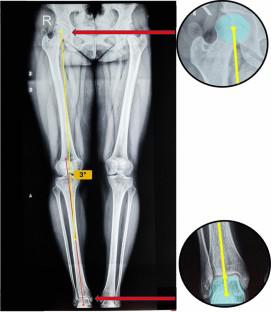Indian Journal of Orthopaedics ( IF 1 ) Pub Date : 2022-09-22 , DOI: 10.1007/s43465-022-00756-8 Praharsha Mulpur 1 , Keyur B Desai 1 , Aakarsh Mahajan 1 , A B Suhas Masilamani 1 , Kushal Hippalgaonkar 1 , A V Gurava Reddy 1

|
Background
Understanding constitutional alignment of the lower limb is essential to optimize alignment strategies during total knee arthroplasty. The coronal plane alignment of knee (CPAK) classification system was proposed as a comprehensive assessment tool based on coronal alignment and variations in joint line obliquity (JLO). This prospective observational cross-sectional study aimed to evaluate the phenotype of knees in the Indian population based on the CPAK system.
Methods
Two cohorts of individuals (250 young healthy volunteers and 250 elderly patients with knee osteoarthritis) underwent radiological assessment with long-leg radiographs and were classified based on the CPAK system. Measurements included the mechanical and arithmetic hip–knee–ankle angles (mHKA, aHKA), joint line obliquity (JLO), lateral distal femoral angle (mLDFA) and medial proximal tibial angle (mMPTA). Knees were grouped into 9 CPAK phenotypes based on aHKA and JLO.
Results
A total of 1000 knees were evaluated. In cohort-1 of healthy young adults, most knees were distributed in the CPAK class II phenotype (128 knees, 25.6%) followed by CPAK Type I (106 knees, 21.2%). In cohort-2 of elderly arthritic adults, most knees were distributed in Type I (294 knees, 58.8%) with constitutional varus and apex-distal joint line orientation.
Conclusion
The majority of the study population was found to have constitutional varus alignment. In addition, a high proportion of patients in both categories, especially arthritic patients undergoing TKA, were found to have varus alignment with an apex-distal oblique joint line. This classification may help optimize component positioning to restore constitutional alignment and joint line orientation during TKA.
中文翻译:

基于膝关节冠状面对准分类 (CPAK) 对印度骨关节炎膝关节表型的放射学评估
背景
了解下肢的体质对位对于优化全膝关节置换术期间的对位策略至关重要。膝关节冠状面对准(CPAK)分类系统是基于冠状对准和关节线倾斜(JLO)变化的综合评估工具。这项前瞻性观察横断面研究旨在基于 CPAK 系统评估印度人群的膝盖表型。
方法
两组个体(250 名年轻健康志愿者和 250 名患有膝骨关节炎的老年患者)接受了长腿 X 光片的放射学评估,并根据 CPAK 系统进行分类。测量包括机械和算术髋膝踝角(mHKA、aHKA)、关节线倾斜度(JLO)、股骨远端外侧角(mLDFA)和胫骨近端内侧角(mMPTA)。根据 aHKA 和 JLO,将膝盖分为 9 种 CPAK 表型。
结果
总共评估了 1000 个膝盖。在健康年轻人的队列 1 中,大多数膝盖分布为 CPAK II 类表型(128 个膝盖,25.6%),其次是 CPAK I 型(106 个膝盖,21.2%)。在老年关节炎患者的队列 2 中,大多数膝关节分布为 I 型(294 个膝关节,58.8%),具有体质内翻和顶端-远端关节线方向。
结论
大多数研究人群被发现患有体质内翻。此外,这两类患者中的很大一部分,尤其是接受全膝关节置换术的关节炎患者,被发现具有与心尖-远端倾斜关节线对齐的内翻排列。这种分类可能有助于优化组件定位,以在 TKA 期间恢复体质对齐和关节线方向。



























 京公网安备 11010802027423号
京公网安备 11010802027423号